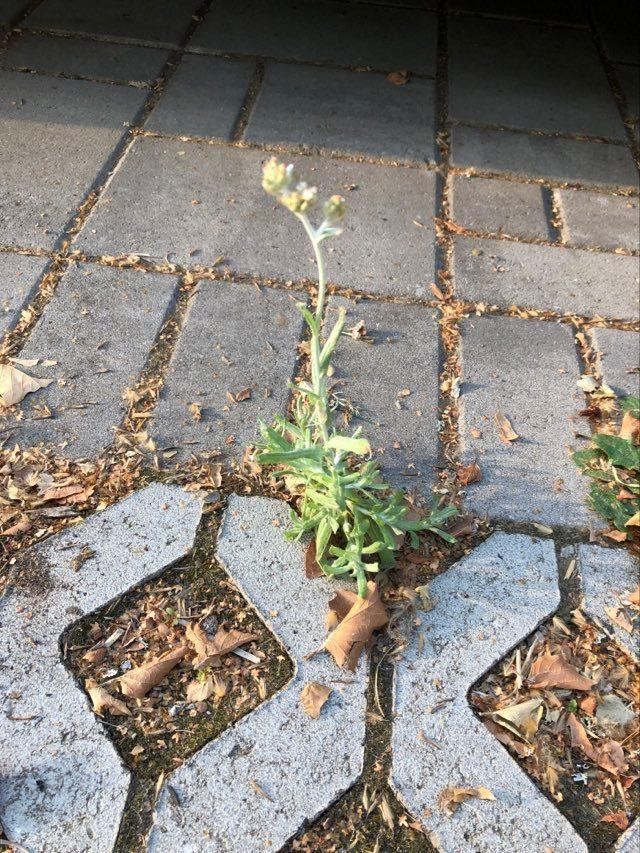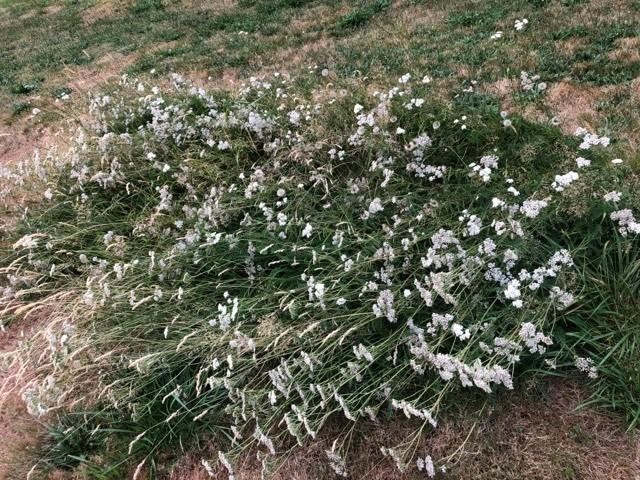By Carrie Falotico, Master Gardener trainee
There is a growing interest amongst gardeners in the Willamette valley to add more native plants to their gardens and landscapes. What if I told you that some of them might just invite themselves into your garden? This has been my experience in my own garden. I wanted to share these four native flowers with you so that you might be able to recognize them if they pop up where you garden.
Pearly Everlasting – Scientific Name: Anaphalis margaritacea


I first discovered pearly everlasting growing in a crack in my walkway. I was about to pluck it, thinking it was a weed. But its soft, silvery leaves gave me pause and I decided to leave it alone to see what might develop. After its sweet little white flowers bloomed, I was able to identify it as pearly everlasting. I learned that it is an incredibly drought-tolerant perennial that is native to most of the United States except for the southwest. It’s also very attractive to pollinators like mining bees, American Lady butterflies, Painted Lady butterflies, the Everlasting Tebenna moth, and sweat bees.
When the flowers dry out, they make attractive additions to floral arrangements.
Fun Fact: “Pearly Everlasting is one of the first plants to colonize recently burned forests. When the rain comes after a fire season, Pearly Everlasting sends out rhizomes that allow the plant to spread rapidly across nutrient-rich areas.”
Find out more about Pearly Everlasting
Douglas Aster Scientific Name: Aster subspicatus or Symphyotrichum subspicatum
I first spied Douglas aster popping up in an area of my yard between a flowering quince and a lavender-bloomed rhododendron. I almost missed it amongst the Nootka rose, (which I will get to presently). It’s probably because the Nootka rose was so dense that I couldn’t really see the Douglas aster until the delicate light purple flowers began to open. I was smitten!
Much like Pearly everlasting, Douglas aster is quite hardy and will tolerate a variety of light and soil conditions. It is drought and is deer resistant. It’s native along the west coast from Alaska to California, also in Idaho and Montana.
Douglas aster provides nectar and pollen to its insect visitors, which include native bees, syrphid flies, and northern checkerspot and woodland skipper butterflies. It may also be a larval host to several different month species.
It can get tall and leggy and can be considered “weedy” by some. It can also be an aggressive spreader, which I personally welcome. It can also be grown in a container, if preferred.
Fun fact from the Garden Ecology Lab: “Douglas aster is a pollinator plant superstar. It is particularly valuable as a late-season pollinator plant, able to provide both nectar and pollen to its visitors when these resources may otherwise be scarce in the landscape.”
Find out more about Douglas aster
Nootka Rose Scientific Name: Rosa nutkana


It’s easy to forgive Nootka rose for almost choking out my favorite lavender flowered rhododendron because the Nootka rose blooms are just so pretty and their red rose hips add a lovely pop of color in the fall and winter.
Nootka Rose is a Northwest native extending from northern California into Alaska and east into Montana, Wyoming, and Colorado. It tolerates a variety of soil, light and drought conditions, and is not affected by pests.
Nootka rose blooms from May through July. The flowers are pink, about 2” across and have a delicate sweet fragrance.
Here are some interesting facts I learned about Nootka rose, as presented in this entry from the Ray Howard Library of the Shoreline Community College, near Seattle, WA:
“Nootka rose produces extensive rhizomes and grows rapidly, making it an ideal plant for revegetation projects. It is used to control soil erosion on hillsides, road cuts and streambanks. Nootka rose has successfully been used for rehabilitating disturbed sites at Columbia River Gorge, Oregon.
“Nootka rose is an important wildlife browse. Mule deer, white-tailed deer, elk, moose, caribou, bighorn sheep, bears, coyotes, and various rodents eat the fruits. Squirrels, mice, beavers, and porcupines eat the twigs and leaves. Nootka rose fruits are preferred by deer, elk, and squirrels. Nootka rose thickets are used for nesting and escape cover by birds and small mammals. Nootka rose provides good cover for waterfowl in Wyoming.”
Find out more about Nootka rose
- Rosa nutkana | Landscape Plants | Oregon State University
- Species Nootka rose, Rosa nutkana K. Presl var. nutkana. (Rosaceae)
Common/Western Yarrow – Scientific name: Achillea millefolium

When we first moved to this property eight years ago, I noticed a small patch of yarrow in our lawn. I was already familiar with this plant, so I was pretty happy to see it. I’ve allowed it to flourish and grow, and now it is quite an impressive patch.
Yarrow is native to most of North America and is a valuable plant for native landscapes and restoration projects because of its ability to quickly grow in disturbed areas, its wide range of soil tolerance (can grow in moist soils except for constantly saturated soils), its ability to compete with exotic weeds and invasive species, its long flowering time, and its value to numerous pollinators.
Fun Fact from the US Forest Service:
“Numerous tribes in North America used yarrow for a variety of ailments. The crushed plant was applied to wounds and burns. The dried leaves were used as a tea to soothe colds, fever, and headache. Yarrow beer has been brewed in Europe since the middle ages. The Chinese considered yarrow plants to be good luck. Even Lewis and Clark were acquainted with yarrow. It was collected during the Lewis and Clark Expedition while they were camped near Kamiah, Idaho in May 1806.”
Find out more about yarrow
- Plant of the Week: Common Yarrow | Garden Ecology Lab
- Western yarrow as a native conservation forb for use in the northern Great Plains and Rocky Mountains
Natives volunteering at your site?
I hope this inspires you to look for natives that might be volunteering in your yard and maybe give something that, at first sight, might seem like a weed a little time to prove itself. You might be pleasantly surprised!
- This is a great resource for helping to identify natives:
OSU Gardening with Oregon Native Plants.pdf - And here is a great app to help identify wildflowers you might encounter: OSU app brings wildflower identification to your fingertips
